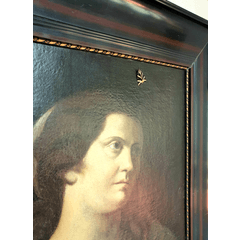Create and correct a digital portrait
Introduction
Hello everyone,
I am Alexandra Bruges, better known as Alexxa16, in this tutorial I am going to share my complete process to create a portrait, I will use realistic proportions but simplified colors and details, from the idea to the final result
With nothing else to add, let's get started
Selection of the reference
To search for a reference, we can use the websites: Pexels, Pixabay or Unplash, where photographers and artists upload royalty-free images, To select the photo search: good lighting and definition, for this exercise select an image from my reference board in pinterest.
Preparation
To focus on the face I decided on a square canvas with 300 px definition, which ensures a good result.
My workspace is very personalized, I am right-handed so I left all the tools on the right so that it was easier to select and on the left I have the browser and subview windows, where I put references I usually use two or three to change the features and add them a personal touch
The sub view window is very practical, you can use it to see your enlarged reference and use the eyedropper on it, if you do not have it you can enter> Window> Subview
Optional - Texture
To give it a more organic touch, add texture to the paper, I did this by changing the background color to a light gray, and dragging the "Drawing paper" texture from the materials, in layer properties change the color of this to white
Bocetaje
Using a color that highlights drawing on the photograph. These ski lines are used to help me locate the features in my sketch. There are some general rules that can be used from face to face, How is it that most people The corner of the lips seems to end in a straight line with the inside of the eyes, Also the line of the eyes It usually coincides with the beginning of the ear, Or also that the space between the 2 eyes Usually coincides with the size of one. Of course we can ignore these Rules for artistic purposes.
Now I try to transfer that to my canvas, I focus on using straight lines or geometric figures, the most important thing is to locate well
On these lines I draw the sketch, when I finish I can hide my red lines
I start to apply the base colors, starting with the largest area that is the skin
with a soft watercolor brush I start to mark the shadows, starting with the largest to follow the face
Fixes
At this point I realize that the colors I chose for the skin I do not like, it is too orange, fortunately I have a trick for this, I will use the very useful correction layers> Gradient, among the free assets that I have downloaded over time I have gradient maps for the skin, I try them and choose the one I like the most, I made some adjustments by moving the arrows until I was happy with the result
As you can see, the correction layer was applied over the entire image, so I used an eraser to eliminate the parts that I did not need, it looks like a mask is created that leaves only the areas that I need
Add a color layer to correct tones, in areas that are too bright or dark
Decor
Using the decorative brushes, it is possible to try different options for the necklaces, and do it quickly
Finishing touches
Add a watercolor background to the assets, also add noise with the perlin filter
Trick
If it happens to you that there is a point in the drawing and you do not know in which layer it is, you can use the Operation button on the point and it will automatically send you to the layer that has the point
Farewell
That's all for today!
Thanks for reading, if you have questions you can ask them in the comments























Comment